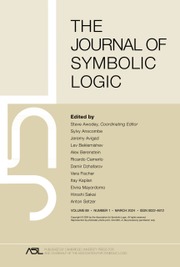No CrossRef data available.
Article contents
RAMSEY-LIKE THEOREMS FOR THE SCHREIER BARRIER
Published online by Cambridge University Press: 17 July 2025
Abstract
The family of finite subsets s of the natural numbers such that  $|s|=1+\min s$ is known as the Schreier barrier in combinatorics and Banach Space theory, and as the family of exactly
$|s|=1+\min s$ is known as the Schreier barrier in combinatorics and Banach Space theory, and as the family of exactly  $\omega $-large sets in Logic. We formulate and prove the generalizations of Friedman’s Free Set and Thin Set theorems and of Rainbow Ramsey’s theorem to colorings of the Schreier barrier. We analyze the strength of these theorems from the point of view of Computability Theory and Reverse Mathematics. Surprisingly, the exactly
$\omega $-large sets in Logic. We formulate and prove the generalizations of Friedman’s Free Set and Thin Set theorems and of Rainbow Ramsey’s theorem to colorings of the Schreier barrier. We analyze the strength of these theorems from the point of view of Computability Theory and Reverse Mathematics. Surprisingly, the exactly  $\omega $-large counterparts of the Thin Set and Free Set theorems can code
$\omega $-large counterparts of the Thin Set and Free Set theorems can code  $\emptyset ^{(\omega )}$, while the exactly
$\emptyset ^{(\omega )}$, while the exactly  $\omega $-large Rainbow Ramsey theorem does not code the halting set.
$\omega $-large Rainbow Ramsey theorem does not code the halting set.
Information
- Type
- Article
- Information
- Copyright
- © The Author(s), 2025. Published by Cambridge University Press on behalf of The Association for Symbolic Logic


